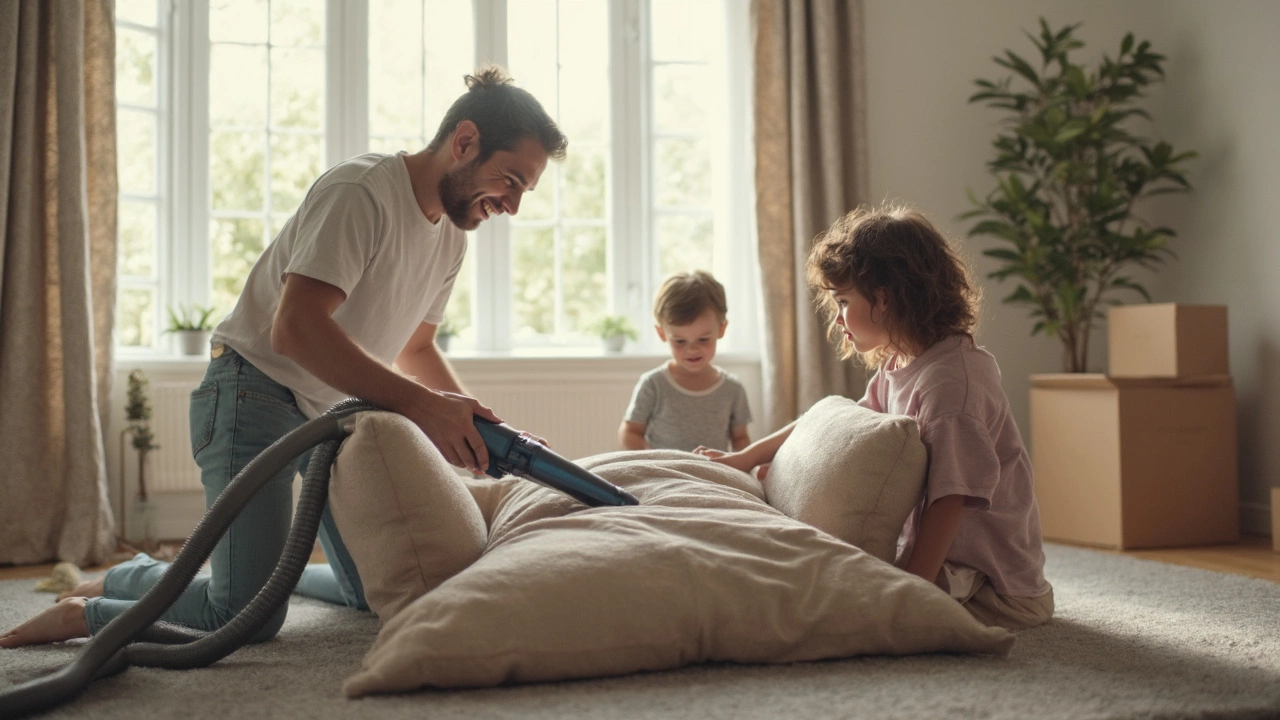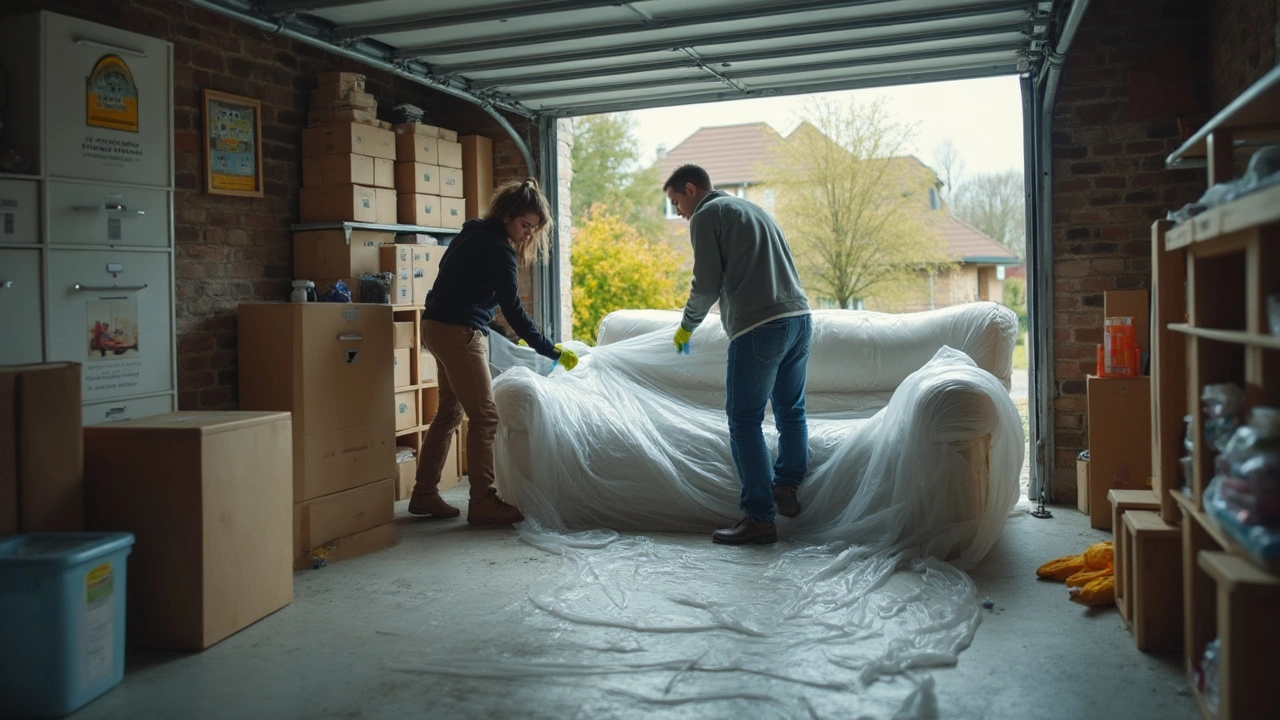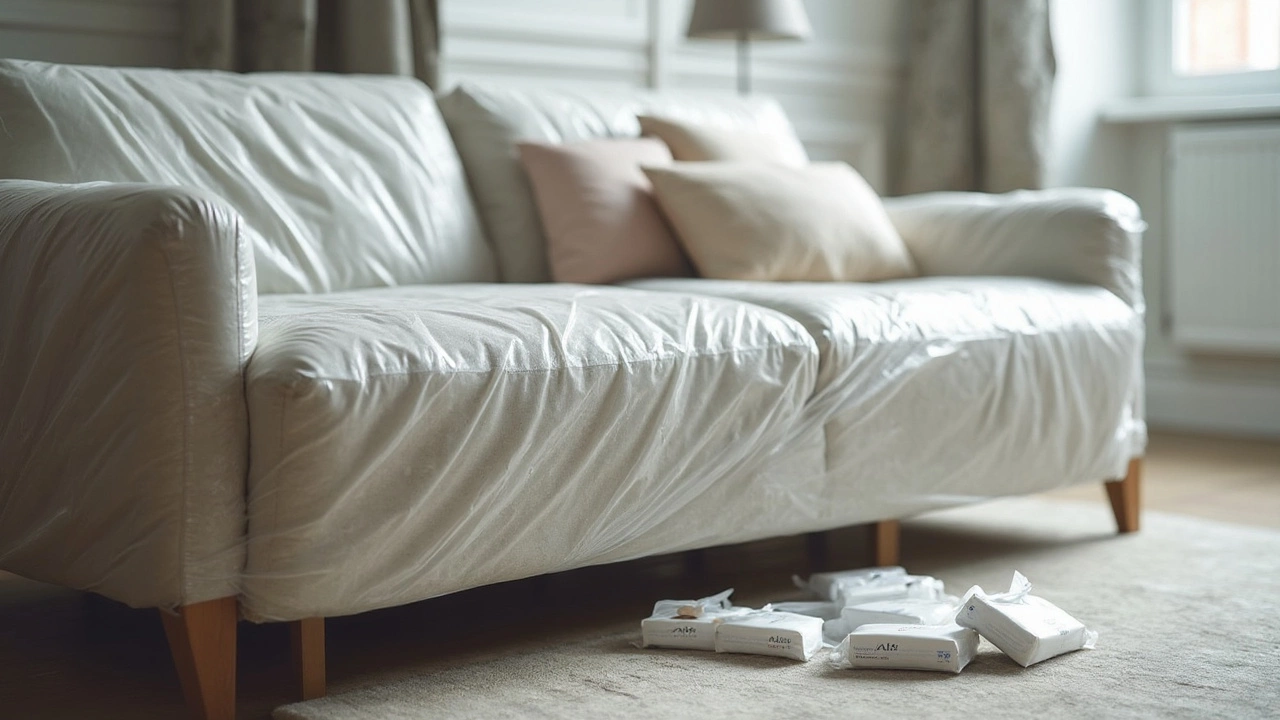 3
May,2025
3
May,2025
Ever opened up storage and realized your couch smells like musty socks? Happens to the best of us. The thing is, sealing your couch the right way makes all the difference between a fresh, comfy return versus a gross surprise.
Before you wrap up your couch and shove it into a storage unit, think about what it’ll face: dust, moisture, bugs, maybe even mice if your spot isn’t super secure. If your couch isn’t sealed right, you might pull it out months later and find weird stains or a colony of ants.
So here's the real talk: If you want your couch to survive storage time without becoming a science project, sealing it is a must. Don't just toss a blanket over it and call it a day. There’s actually a right way that doesn’t take a ton of effort, but saves you money and headaches down the line.
- Why Bother Sealing a Couch?
- Getting Your Couch Ready
- Picking the Right Supplies
- The Step-by-Step Sealing Process
- Mistakes to Avoid
Why Bother Sealing a Couch?
If you’re thinking storing a couch is like storing a box of winter sweaters, here’s a reality check: furniture’s got way more to lose. Fabric, wood, even the metal springs inside—each one is asking for trouble if you don’t protect it right. Leaving your couch uncovered is almost like leaving your front door open all winter. Anything can happen, and most of it isn’t good.
One big problem is moisture. Humidity sneaks in, and just a little trapped water can turn your upholstery into a mold magnet in as little as two weeks. According to the CDC, soft furniture is especially vulnerable to mold if there's over 60% humidity. Now imagine what a humid storage space can do in a few months.
Then there’s dust and dirt. These tiny bits sneak everywhere and act like sandpaper on fabric when you uncover your couch and give it a quick brush—suddenly, it looks faded or worn out. And forget about odors—fabric holds onto every bit of musty air, turning a nice couch into something you’d be embarrassed to offer a guest.
| Problem | What Can Happen |
|---|---|
| Mold | Stains, smells, health risks |
| Pests | Chewed fabric, nests inside cushions |
| Dust | Permanent discoloration, gritty feel |
| Moisture | Warped frames, rusty springs |
Pests aren’t just a city thing. In storage units or garages, mice and bugs see your couch like an Airbnb. Without a proper seal, you’re basically putting up a sign for them. Sealing your couch is like locking your door—keeps out everything you don’t want.
Fact: A properly sealed couch can make it through long-term storage with barely a scratch. People who use airtight wraps or furniture covers report less fabric damage and fewer pest problems, compared to those who just throw on a sheet or nothing at all.
Bottom line: sealing a couch isn’t being extra careful, it’s just basic furniture insurance. Spend a little effort now, skip the heartbreak when you move your stuff back in.
Getting Your Couch Ready
First thing: you can't just toss your couch into storage without a plan. Storing couches the lazy way usually ends with regret. Start by cleaning it like you're showing it to your in-laws. Any crumbs, dust, or pet hair (shoutout to my cat, Tigger) left on the couch can turn into big problems—mold, bugs, weird smells you do not want to deal with later.
Grab your vacuum and hit every crack and cushion. For fabric couches, don't just skim the surface—take off any removable covers and toss them in the wash if the tag says it's safe. If your couch has stains, hit them up with a fabric-safe cleaner. Leather and faux leather? Wipe it down with a damp (not soaking) cloth and mild soap, then dry it off completely. Water left behind can cause mildew, so don’t skip this part.
Moisture is the enemy here. Make sure your couch is 100% dry before you move to the next step. Even a little leftover dampness can make your furniture protection plan pointless because you’re basically sealing in future problems.
If your couch has loose legs or arms, unscrew and store them in a plastic bag taped underneath. Less chance of snapping something or having an awkward shape that's hard to wrap or move around.
Check the sofa’s tag or manual. Some couches have stuffing or materials that shouldn’t be squished for months. If there are recommendations from the manufacturer, follow them—they don’t just make those up for fun.
- Vacuum and clean all surfaces
- Remove and wash covers if possible
- Spot clean stains with appropriate cleaner
- Wipe down leather or faux leather and fully dry
- Disassemble any removable parts
- Double-check everything is bone dry
You’re setting the foundation for an easy seal. Skipping this step is asking for a smelly, ruined couch later—trust me, it’s worth the extra fifteen minutes now.

Picking the Right Supplies
You wouldn’t jump into sealing a couch for storage with just any supplies. There’s a reason the pros don’t use kitchen trash bags and painter’s tape for these jobs—it just isn’t enough to keep out moisture or pests.
The real MVP here? Heavy-duty plastic wrap. We’re talking the thick stuff, usually 3-5 mils (thousandths of an inch) thick. That’s sturdy enough to block dust and water but flexible enough to wrap around any furniture shape. If you’re sealing leather, vinyl, or fabric, this wrap keeps everything tight and protected. Forget flimsy moving blankets unless you’re pairing them under the plastic for extra padding and scratch prevention.
Here’s what you actually need for the job:
- Plastic furniture wrap (at least 3 mils thick)
- Moving blankets or old sheets (for a soft under-layer and extra scratch protection)
- Packing tape or stretch film tape – the sticky kind that keeps plastic secure
- Moisture absorbers—like silica gel packs or DampRid, found at any hardware store
- Mothballs or cedar blocks, which naturally keep bugs out without leaving weird scents like bug sprays
- Permanent marker for labeling, so you or movers know what’s inside later
Some people skip moisture absorbers, but that’s a rookie mistake. According to the American Moving & Storage Association, "Humidity is one of the main reasons stored furniture develops odors or mold. Including moisture control products in your packaging can make all the difference."
"Humidity is one of the main reasons stored furniture develops odors or mold. Including moisture control products in your packaging can make all the difference."
—American Moving & Storage Association
And don’t cheap out on tape. The wrong kind peels off in heat or cold. You want the good sticky stuff—usually labeled as ‘moving’ or ‘stretch wrap’ tape at hardware stores.
Here’s a quick side-by-side for what works versus what doesn’t:
| Works Well | Won't Cut It |
|---|---|
| Heavy-duty plastic wrap | Kitchen plastic wrap |
| Stretch film/moving tape | Painters or masking tape |
| Silica gel or DampRid | Nothing/ignoring humidity |
| Moving blankets under plastic | Loose sheets or towels by themselves |
If you want your couch storage game to be rock solid, don’t try to improvise this part. Spending a few extra bucks on real moving materials now saves you a world of regret later—just ask Tigger, my cat, who would love nothing more than to nap on any couch, sealed or not.
The Step-by-Step Sealing Process
Alright, let’s get your couch storage game on point. Here’s how you really nail the sealing process so your sofa survives months (or even years) in storage without turning into a disaster zone.
- Vacuum Like You Mean It
Hit every cushion, every crack, and the back. Dust, food crumbs, and even pet hair (Tigger, looking at you) invite bugs. Don’t skip this part. Use the brush nozzle or an upholstery attachment to get deep into seams. - Spot-Clean Stains
Grab a fabric cleaner that matches your material, whether you’ve got microfiber or old-school leather. Make sure all stains are dried out before moving to the next step, or you risk baking in bad odors. - Air It Out
If you’ve cleaned any spots, let the couch dry completely. Sealing moisture means you’ll invite mold — and nobody wants that. Give it extra time if your couch is bulky or thick; sometimes overnight is best. - Wrap With Furniture Plastic
Buy heavy-duty plastic wrapping or shrink wrap (the thicker, the better—think 5-6 mil). Wrap the entire couch tightly, but leave tiny ventilation holes along the base if you’re storing for more than a few months to avoid trapped moisture. Never use regular garbage bags—they rip way too easily. - Tape Down the Edges
Use packing tape or strong duct tape to seal seams and secure the plastic. Make it tight but don’t squeeze the cushions out of shape. For leather couches, add a fabric drop cloth layer under the plastic to help with breathability. - Lift Off the Ground
If your storage unit has concrete floors (a lot do), put the couch on pallets or blocks. This protects your furniture from surprise leaks or humidity creeping up from below. Anything between the couch and the ground is better than nothing.
Here’s a quick look at what happens if you skip a step:
| Skipped Step | Common Problem |
|---|---|
| No vacuum | Insects and foul smells |
| Wet stains | Mold and mildew |
| No plastic wrap | Dust and moisture damage |
| On floor | Water damage |
This process makes sealing a couch for storage way more reliable, and you won’t cringe when it’s time to unwrap your furniture. If you want extra peace of mind, toss in a moisture absorber packet under the wrap. It’s a small step, but it makes a big difference for long-term storage.

Mistakes to Avoid
Messing up on sealing your couch for storage is easier than you’d think. Some mistakes pop up all the time, turning what could’ve been a simple task into a total headache. Let’s talk about the stuff you don’t want to do when you try to seal a couch for storage.
- Wrapping While It’s Dirty: Sealing in crumbs, pet hair, or stains is an open invite for mold, weird smells, or even bugs. Always vacuum, wipe, and check inside the cushions before you even reach for anything to wrap it with.
- Using the Wrong Materials: A plain plastic tarp or trash bags won’t do the trick. They trap moisture, and that leads to mold. Go for furniture-grade plastic wrap or thick moving blankets if you can’t use plastic. If you want real airtight results, use heavy-duty airtight couch wrap.
- Taping Directly On Fabric: Tape leaves sticky residue, and pulling it off can ruin your couch’s fabric. Always tape to the wrap, not your couch.
- Poor Airflow: If you totally seal your couch without considering airflow, moisture trapped inside can turn into mildew. Throw in moisture absorbers or silica gel packs, and if you’re storing long-term, crack the seal to let it breathe every few months.
- Forgetting Pest Protection: Mice love the inside of a soft couch. Don’t skip pest deterrents—peppermint oil or commercial pest packs are worth it, and make sure storage units are clean and rodent-free.
Here’s a hot tip that people ignore: Don’t store your sealed couch directly on a concrete floor. Concrete holds moisture and can damage the frame. Always put pallets or thick plastic underneath. According to a report from the Self Storage Association:
| Storage Method | Risk of Mold (%) |
|---|---|
| Direct on Concrete | 42 |
| Raised on Pallets | 7 |
That’s a huge difference in avoiding that musty couch fate no one wants.
"Moisture buildup is the number one cause of damage in stored upholstered furniture. Proper ventilation and a moisture barrier go a long way in extending your couch’s life." — National Association of Professional Organizers
Stay sharp—these slip-ups can cost you time and money. Handle each step with care, and your furniture protection plan will actually work the way you want it to.




